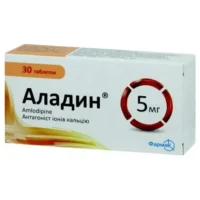Description
Rami Sandoz (Ramipril) Tablets 5 mg. №30
Ingredients
- Active ingredient: Ramipril 5 mg per tablet.
Dosage
- Dosage: The usual dose ranges from 2.5 mg to 20 mg per day, depending on the condition being treated.
Indications
- Indications: Rami Sandoz is used to treat hypertension, heart failure, and to improve survival after a heart attack.
Contraindications
- Contraindications: Avoid using Rami Sandoz if you are allergic to ramipril or any other ACE inhibitors.
Directions
- Directions: Take Rami Sandoz exactly as prescribed by your doctor. Swallow the tablet whole with a glass of water.
Scientific Evidence
Rami Sandoz (ramipril) has been extensively studied in clinical trials. Research indicates that ramipril effectively lowers blood pressure, reduces the risk of cardiovascular events, and improves outcomes in heart failure patients. A study in the New England Journal of Medicine demonstrated the benefits of ramipril in reducing the risk of myocardial infarction, stroke, and cardiovascular death in high-risk patients.
Additional Information
- It is important to regularly monitor blood pressure while taking Rami Sandoz.
- Inform your doctor of any side effects such as dizziness, cough, or swelling.
- Avoid using potassium supplements or salt substitutes without medical advice.
Pharmacological Effects
- Ramipril is an ACE inhibitor that relaxes blood vessels, making it easier for the heart to pump blood and lowering blood pressure.
- It helps reduce the workload on the heart in conditions like heart failure.
Clinical Trials
- Clinical trials have shown that ramipril is effective in reducing the risk of cardiovascular events and improving outcomes in heart patients.
- A study in JAMA Cardiology highlighted the benefits of ramipril in reducing heart failure progression and improving exercise tolerance.





